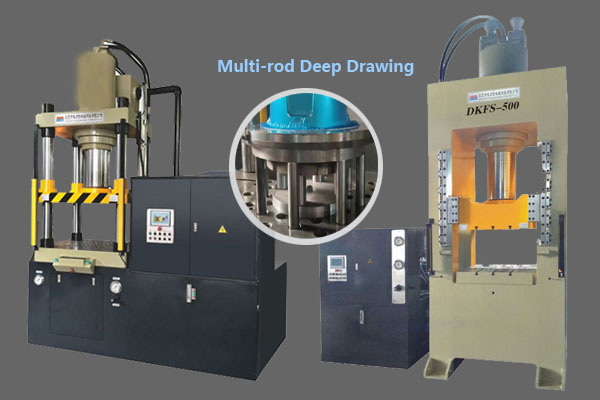Common Problems of Multi-rod Deep Drawing Hydraulic Press
2025-05-05 16:53:03
Multi-rod deep drawing hydraulic presses are essential for forming complex metal parts, but they can face several operational and mechanical issues. During the drawing process, multiple ejector pins are evenly distributed around the workbench or die. These ejector pins are controlled by independent hydraulic cylinders. The extension length, pressure and movement speed of each ejector pin can be accurately adjusted according to different process requirements and die shapes, so that the metal sheet is subjected to uniform force during the stretching process to avoid local excessive deformation.

Following are common problems of multi-rod deep drawing hydraulic press.
1. Uneven Pressure Distribution
● Symptoms: Wrinkling, cracking, or inconsistent part thickness.
● Causes:
○ Misaligned rods or cylinders.
○ Uneven hydraulic pressure in multiple cylinders.
○ Worn or damaged seals causing pressure leaks.
2. Rod Misalignment or Bending
● Symptoms: Uneven wear on rods, jerky movement, or machine vibration.
● Causes:
○ Improper installation or leveling.
○ Excessive off-center loading.
○ Fatigue or overloading beyond capacity.
3. Hydraulic Fluid Leaks
● Symptoms: Oil puddles, loss of pressure, reduced efficiency.
● Causes:
○ Damaged seals or O-rings.
○ Loose fittings or cracked hoses.
○ Excessive heat degrading seals.
4. Overheating of Hydraulic System
● Symptoms: Slow operation, fluid thinning, burnt oil smell.
● Causes:
○ Continuous high-pressure operation without cooling.
○ Clogged or insufficient cooling system.
○ Low hydraulic fluid levels or poor-quality oil.
5. Sticking or Jerky Movement
● Symptoms: Inconsistent ram speed, hesitation during stroke.
● Causes:
○ Contaminated hydraulic fluid (dirt, water, air bubbles).
○ Worn-out piston or cylinder scoring.
○ Faulty control valves or servo systems.
6. Excessive Noise & Vibration
● Symptoms: Loud knocking, grinding, or shaking during operation.
● Causes:
○ Loose structural bolts or misalignment.
○ Cavitation in hydraulic pumps.
○ Worn bearings or guide bushings.
7. Poor Surface Finish on Drawn Parts
● Symptoms: Scratches, galling, or rough edges.
● Causes:
○ Improper lubrication on dies or blank holder.
○ Incorrect blank holder pressure.
○ Worn or damaged tooling.
8. Slow Cycle Times
● Symptoms: Reduced productivity, delayed strokes.
● Causes:
○ Hydraulic pump inefficiency.
○ Undersized motor or accumulator issues.
○ Valve response delays.
Preventive Measures & Solutions
● Regular maintenance (check seals, fluid levels, alignment).
● Proper lubrication of rods and dies.
● Monitor hydraulic fluid quality and temperature.
● Ensure correct machine setup (pressure, stroke speed, alignment).
Performance advantages of multi-rod deep drawing hydraulic press from Goodsjack Hydraulic Machinery.
● Improve product quality: The uniform pressure and precise control of multiple ejectors make the metal sheet evenly stressed during the stretching process, effectively avoiding defects such as wrinkling and cracking, improving the dimensional accuracy and surface quality of the product, and reducing the defective rate.
● Improve production efficiency: The fast stretching speed and efficient hydraulic system can shorten the time of each working cycle, and at the same time realize automatic operation, reduce manual intervention, improve production efficiency, and reduce production costs.
● Enhance process adaptability: According to different workpiece shapes, sizes and stretching process requirements, the number, position, pressure and movement speed of ejectors can be flexibly adjusted to meet the needs of various complex stretching processes, with strong process adaptability and flexibility.

Following are common problems of multi-rod deep drawing hydraulic press.
1. Uneven Pressure Distribution
● Symptoms: Wrinkling, cracking, or inconsistent part thickness.
● Causes:
○ Misaligned rods or cylinders.
○ Uneven hydraulic pressure in multiple cylinders.
○ Worn or damaged seals causing pressure leaks.
2. Rod Misalignment or Bending
● Symptoms: Uneven wear on rods, jerky movement, or machine vibration.
● Causes:
○ Improper installation or leveling.
○ Excessive off-center loading.
○ Fatigue or overloading beyond capacity.
3. Hydraulic Fluid Leaks
● Symptoms: Oil puddles, loss of pressure, reduced efficiency.
● Causes:
○ Damaged seals or O-rings.
○ Loose fittings or cracked hoses.
○ Excessive heat degrading seals.
4. Overheating of Hydraulic System
● Symptoms: Slow operation, fluid thinning, burnt oil smell.
● Causes:
○ Continuous high-pressure operation without cooling.
○ Clogged or insufficient cooling system.
○ Low hydraulic fluid levels or poor-quality oil.
5. Sticking or Jerky Movement
● Symptoms: Inconsistent ram speed, hesitation during stroke.
● Causes:
○ Contaminated hydraulic fluid (dirt, water, air bubbles).
○ Worn-out piston or cylinder scoring.
○ Faulty control valves or servo systems.
6. Excessive Noise & Vibration
● Symptoms: Loud knocking, grinding, or shaking during operation.
● Causes:
○ Loose structural bolts or misalignment.
○ Cavitation in hydraulic pumps.
○ Worn bearings or guide bushings.
7. Poor Surface Finish on Drawn Parts
● Symptoms: Scratches, galling, or rough edges.
● Causes:
○ Improper lubrication on dies or blank holder.
○ Incorrect blank holder pressure.
○ Worn or damaged tooling.
8. Slow Cycle Times
● Symptoms: Reduced productivity, delayed strokes.
● Causes:
○ Hydraulic pump inefficiency.
○ Undersized motor or accumulator issues.
○ Valve response delays.
Preventive Measures & Solutions
● Regular maintenance (check seals, fluid levels, alignment).
● Proper lubrication of rods and dies.
● Monitor hydraulic fluid quality and temperature.
● Ensure correct machine setup (pressure, stroke speed, alignment).
Performance advantages of multi-rod deep drawing hydraulic press from Goodsjack Hydraulic Machinery.
● Improve product quality: The uniform pressure and precise control of multiple ejectors make the metal sheet evenly stressed during the stretching process, effectively avoiding defects such as wrinkling and cracking, improving the dimensional accuracy and surface quality of the product, and reducing the defective rate.
● Improve production efficiency: The fast stretching speed and efficient hydraulic system can shorten the time of each working cycle, and at the same time realize automatic operation, reduce manual intervention, improve production efficiency, and reduce production costs.
● Enhance process adaptability: According to different workpiece shapes, sizes and stretching process requirements, the number, position, pressure and movement speed of ejectors can be flexibly adjusted to meet the needs of various complex stretching processes, with strong process adaptability and flexibility.



 TOP
TOP WINDOWS
WINDOWS